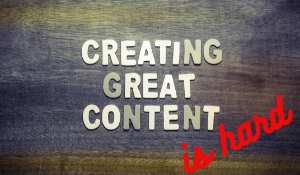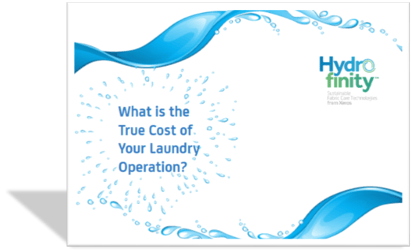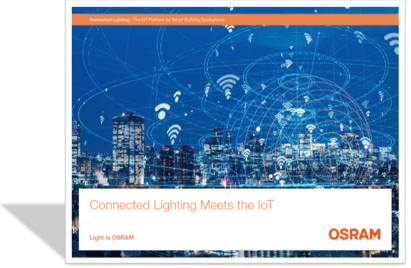 Creating compelling content is not easy these days. There are lots of content out there, and the competition is fierce for eyeballs. Smaller companies are competing with bigger brands with significantly larger budgets for content creation and distribution. There is a trend that is moving away from gated content and towards intent data which is expensive and still not proven. It is getting harder and harder to capture someone's information in exchange for a piece of content.
Creating compelling content is not easy these days. There are lots of content out there, and the competition is fierce for eyeballs. Smaller companies are competing with bigger brands with significantly larger budgets for content creation and distribution. There is a trend that is moving away from gated content and towards intent data which is expensive and still not proven. It is getting harder and harder to capture someone's information in exchange for a piece of content.
Even though there are challenges, there will always be a need for explainers - content that educates buyers in a compelling and engaging way.
So, what do you need to create great content?
- A clear understanding of your targeted audience – I can't stress this point enough. Taking a shotgun approach to content creation where you are trying to satisfy many different audiences doesn't work. It dilutes the content and never hits the true pain points of the audience. The first step is to create buyer personas. A buyer persona is a semi-fictional representation of your ideal customer based on market research and real data from your sales team about your existing customers. Personas can be very simple or more in-depth, where the persona's involvement is documented at each stage of the buying cycle.
- Focus on your customer's pain points - Work closely with your sales team to understand the motivations and objections raised by prospects during the buying process. Once you understand what motivates them and their objections, you can address those concerns in your content. The key to creating compelling content is to understand your customer's pain points.
- Speak their language – Have you ever attended an event where techies are talking shop? If you are not from the tech world, you will find it difficult to follow any conversations. For example, in this ebook focused on Precision Tooling, we are targeting operation managers, engineers, and job shop owners in manufacturing. They have their own language and acronyms, To establish credibility, your need to speak in your target's language. Different industries and functions have their own language.
- Hook your audience with a persuasive headline – On average, 8 out of 10 people will read headline copy, but only 2 out of 10 will read the rest of the content. BuzzSumo's research of 100 million headlines on Facebook and Twitter found approximately 65 characters (about 11 words) is the sweet spot for headline length.
- Add an appropriate call-to-action (CTA) – Ensure that the CTA adds value to the topic you are discussing. In addition, make sure the CTA is aligned with the buying journey. For example, if you provide TOF content, don't offer up a BOF offer or give your reader a random piece of content with nothing to do with the current topic. Here is an example of a blog post that offers an appropriate CTA - this playbook has been downloaded thousands of times.
- Add validation and trust factors - Support the points in your content by linking out to authoritative sources such as documented research, mainstream media sources, government sites, and universities. In addition, anytime you can support a point with customer quotes or anecdotal customer information helps establish credibility. In this blog post, How the Marketing Flywheel Gets You A Bigger Budget, we used LinkedIn research to validate our advice.
- Put yourself in your audience's shoes – Remember, in the B2B world, your target audience is very busy. Unless they are past the research phase and have entered into the buying cycle, the last thing they want to do is read a twenty-page, text-heavy white paper. So instead, consider creating a series of easy-to-read ebooks or videos that provide the information they need in digestible portions.
Examples of Great Content
 How to Content - This playbook has been downloaded thousands of times. It is a digital marketing primer targeted to marketing managers and executives in manufacturing and industrial companies. It educates the audience on how to digitally transform marketing and sales to be successful in the era of Industry 4.0. Most manufacturing and industry companies don't think of their marketing and sales processes holistically. This playbook helps them think of it as an integrated strategy. Click on the image to download the playbook.
How to Content - This playbook has been downloaded thousands of times. It is a digital marketing primer targeted to marketing managers and executives in manufacturing and industrial companies. It educates the audience on how to digitally transform marketing and sales to be successful in the era of Industry 4.0. Most manufacturing and industry companies don't think of their marketing and sales processes holistically. This playbook helps them think of it as an integrated strategy. Click on the image to download the playbook.
 See how your peers are using it - This ebook tells a story about how customer engagement technology helps banks create a differentiated customer experience and is a foundational tool for increasing brand loyalty and success. It is a compilation of four case studies with a common theme that illustrate the value of customer engagement technology. Click on the image to download the ebook. www.ignitesales.com
See how your peers are using it - This ebook tells a story about how customer engagement technology helps banks create a differentiated customer experience and is a foundational tool for increasing brand loyalty and success. It is a compilation of four case studies with a common theme that illustrate the value of customer engagement technology. Click on the image to download the ebook. www.ignitesales.com
 Imagine the possibilities - In this ebook, we explore a whole host of applications that are enabled by edge computing. Edge computing is a a distributed version of cloud computing and is early in its technology cycle. Since it isn't widely adopted, it is imperative that Veea take a thought leadership position and educate the industry on how edge computing can be used in smart buildings. Click on the image to get a closer look. www.veea.com
Imagine the possibilities - In this ebook, we explore a whole host of applications that are enabled by edge computing. Edge computing is a a distributed version of cloud computing and is early in its technology cycle. Since it isn't widely adopted, it is imperative that Veea take a thought leadership position and educate the industry on how edge computing can be used in smart buildings. Click on the image to get a closer look. www.veea.com
 Put yourself in your audience's shoes - This ebook is a simplified version of a very complex white paper. The target audience is industrial laundry operations managers where English is possibly a second language. Click on the image to download.
Put yourself in your audience's shoes - This ebook is a simplified version of a very complex white paper. The target audience is industrial laundry operations managers where English is possibly a second language. Click on the image to download.
Focus on your customer's pain points - This ebook was targeted at commercial building facility managers and owners. This audience is not technically savvy but are the primary decision makers for lighting systems. This ebook educates them on the basics of IoT and its impact on lighting systems Click on the image to download..





